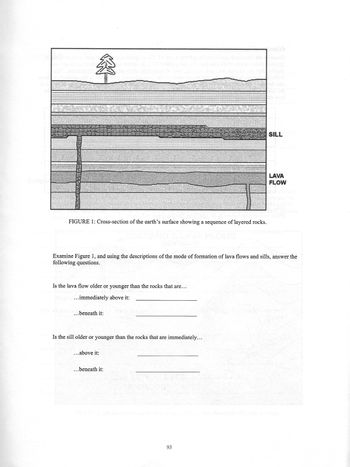
Applications and Investigations in Earth Science (9th Edition)
9th Edition
ISBN: 9780134746241
Author: Edward J. Tarbuck, Frederick K. Lutgens, Dennis G. Tasa
Publisher: PEARSON
expand_more
expand_more
format_list_bulleted
Question

Transcribed Image Text:WINSTIAKA
$
FIGURE 1: Cross-section of the earth's surface showing a sequence of layered rocks.
Is the lava flow older or younger than the rocks that are...
...immediately above it:
Examine Figure 1, and using the descriptions of the mode of formation of lava flows and sills, answer the
following questions.
..beneath it:
Is the sill older or younger than the rocks that are immediately...
...above it:
...beneath it:
SILL
93
LAVA
FLOW

Transcribed Image Text:Many aspects of rock origins are best understood if a rock is considered in terms of its relationships with its
neighbors. Such relationships are best seen 'in the field', where the rock is in its natural setting. As an example of
this approach, we will consider several field situations to see what light they shed on the origin of rocks.
Procedure
Three duplicate sets of samples are placed about the room. Work with one set. Each set has 5 boxes, one for each of
the 5 exercises that comprise this laboratory. The exercises may be done in any
order.
Sample Set #1
Age Relationships of Layered Rocks
Geologists quantify the immense time spans involved in earth history by establishing a reference point in
time, and then counting backwards from that reference point using convenient time units. Geologists use
the modem era as a reference point and reckon time backwards to the time of occurrence of a geologic
event, as for example, the formation of a rock. Thus, to say that a sandstone is 100 million years old means
that 100 million years ago, that sandstone was in the process of formation, perhaps as a sandy beach along
an ancient coastline. This is a familiar approach because it is essentially the same as we take in dealing with
everyday life. The major difference is that we use different time units (weeks, days, minutes) to measure
the short time scales characterizing our day-to-day affairs
Geologists can determine the relative ages of the layers in a sequence of layered rocks from the positions of
the layers in the sequence. Generally, a given layer is younger than (i.e. formed more recently) the layer
below it and older than (i.e. formed before) the layer above it. This idea is referred to as the Principle of
Superposition. Figure 1, on the next page, is a cross section showing a horizontal sequence of interbedded
sedimentary and igneous rocks, and illustrates how this principle can be applied to interpreting the relative
ages of rocks. Figure 1 illustrates also that sometimes the age of specific rock layers may not adhere to the
'younging upward' tenet expressed in the idea of superposition. These exceptions are, however, relatively
rare.
There are two ways in which the igneous layers diagrammed in Figure 1, may have become part of this
sequence:
Lava Flow: An igneous layer may be a lava flow which was erupted onto the earth's surface from
a volcanic vent. The flowing lava covered the sedimentary rock layers beneath it. At a later time,
after the lava had cooled and turned to rock, it was buried by a new influx of sediment, thus
becoming part of the layered sequence.
Sill: Molten rock, working its way upward through the layered sequence, did not reach the surface of
the earth. Instead, while still below ground level, it wedged, or intruded, itself laterally between
two of the sedimentary layers in the sequence, where it eventually cooled and became a rock. This
intrusive body, called a sill, thus became part of the layered sequence.
92
TARI
Expert Solution
This question has been solved!
Explore an expertly crafted, step-by-step solution for a thorough understanding of key concepts.
This is a popular solution
Trending nowThis is a popular solution!
Step by stepSolved in 7 steps

Knowledge Booster
Recommended textbooks for you
 Applications and Investigations in Earth Science ...Earth ScienceISBN:9780134746241Author:Edward J. Tarbuck, Frederick K. Lutgens, Dennis G. TasaPublisher:PEARSON
Applications and Investigations in Earth Science ...Earth ScienceISBN:9780134746241Author:Edward J. Tarbuck, Frederick K. Lutgens, Dennis G. TasaPublisher:PEARSON Exercises for Weather & Climate (9th Edition)Earth ScienceISBN:9780134041360Author:Greg CarbonePublisher:PEARSON
Exercises for Weather & Climate (9th Edition)Earth ScienceISBN:9780134041360Author:Greg CarbonePublisher:PEARSON Environmental ScienceEarth ScienceISBN:9781260153125Author:William P Cunningham Prof., Mary Ann Cunningham ProfessorPublisher:McGraw-Hill Education
Environmental ScienceEarth ScienceISBN:9781260153125Author:William P Cunningham Prof., Mary Ann Cunningham ProfessorPublisher:McGraw-Hill Education Earth Science (15th Edition)Earth ScienceISBN:9780134543536Author:Edward J. Tarbuck, Frederick K. Lutgens, Dennis G. TasaPublisher:PEARSON
Earth Science (15th Edition)Earth ScienceISBN:9780134543536Author:Edward J. Tarbuck, Frederick K. Lutgens, Dennis G. TasaPublisher:PEARSON Environmental Science (MindTap Course List)Earth ScienceISBN:9781337569613Author:G. Tyler Miller, Scott SpoolmanPublisher:Cengage Learning
Environmental Science (MindTap Course List)Earth ScienceISBN:9781337569613Author:G. Tyler Miller, Scott SpoolmanPublisher:Cengage Learning Physical GeologyEarth ScienceISBN:9781259916823Author:Plummer, Charles C., CARLSON, Diane H., Hammersley, LisaPublisher:Mcgraw-hill Education,
Physical GeologyEarth ScienceISBN:9781259916823Author:Plummer, Charles C., CARLSON, Diane H., Hammersley, LisaPublisher:Mcgraw-hill Education,

Applications and Investigations in Earth Science ...
Earth Science
ISBN:9780134746241
Author:Edward J. Tarbuck, Frederick K. Lutgens, Dennis G. Tasa
Publisher:PEARSON

Exercises for Weather & Climate (9th Edition)
Earth Science
ISBN:9780134041360
Author:Greg Carbone
Publisher:PEARSON

Environmental Science
Earth Science
ISBN:9781260153125
Author:William P Cunningham Prof., Mary Ann Cunningham Professor
Publisher:McGraw-Hill Education

Earth Science (15th Edition)
Earth Science
ISBN:9780134543536
Author:Edward J. Tarbuck, Frederick K. Lutgens, Dennis G. Tasa
Publisher:PEARSON

Environmental Science (MindTap Course List)
Earth Science
ISBN:9781337569613
Author:G. Tyler Miller, Scott Spoolman
Publisher:Cengage Learning

Physical Geology
Earth Science
ISBN:9781259916823
Author:Plummer, Charles C., CARLSON, Diane H., Hammersley, Lisa
Publisher:Mcgraw-hill Education,